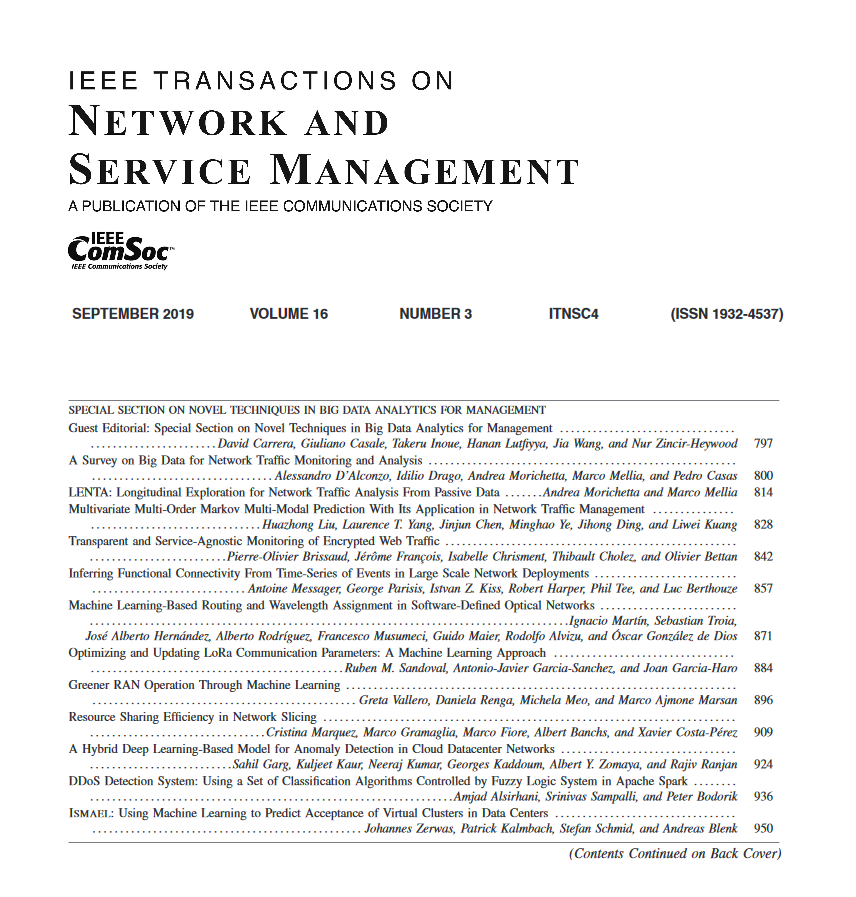利用队列信息实现确定性网络中可扩展的延迟受限路由选择
IF 4.7
2区 计算机科学
Q1 COMPUTER SCIENCE, INFORMATION SYSTEMS
IEEE Transactions on Network and Service Management
Pub Date : 2024-07-29
DOI:10.1109/TNSM.2024.3435769
引用次数: 0
摘要
下一代互联网需要严格的端到端延迟保证,以支持即将到来的延迟敏感型应用。IEEE 802.1 时敏网络(TSN)标准已成为基于以太网的 L2 网络的实际解决方案,以支持对延迟、抖动和丢包有严格要求的应用。IETF DetNet 工作组试图扩展 TSN,以支持更大规模 L3 网络上的实时应用。本文提出了在 L3 网络中提供延迟保证的控制和路由策略,而不要求节点间的时间同步。提出的策略包括一个链路状态路由协议和几个基于探索的协议,这些协议利用队列级信息和网络计算来提供延迟保证。此外,队列延迟预算的使用实现了流之间的独立性,同时实现了细粒度路由。这样就能做出更好的路由决策,并支持具有不同延迟要求的应用。此外,只需要在网络入口处进行流量整形。我们在仿真环境中对这些策略进行了广泛评估,并在多个大规模场景中进行了比较,考虑了接受率、网络利用率、路径传播时间、控制开销和内存消耗,以及这些指标在不同网络规模下的演变情况。实验结果表明,只有在较小规模的网络中,队列级链路状态路由协议才能充分满足具有代表性的延迟受限流量需求。在较大规模的网络场景中,基于广度优先探索的协议需要以线性增加的控制开销和内存占用为代价,在接受率和路径传播时间方面提供稳定的性能。本文章由计算机程序翻译,如有差异,请以英文原文为准。
Exploiting Queue Information for Scalable Delay-Constrained Routing in Deterministic Networks
Next-generation Internet will require strict end-to-end delay guarantees to support upcoming latency-sensitive applications. The IEEE 802.1 Time-Sensitive Networking (TSN) standard has become the de-facto solution for Ethernet-based L2 networks to support applications with strict latency, jitter and packet loss requirements. The IETF DetNet Working Group tries to expand on TSN to support real-time applications over larger-scale L3 networks. This paper proposes control and routing strategies that provide latency guarantees in L3 networks without requiring time synchronization among nodes. The proposed strategies include a link-state routing protocol and several exploration-based protocols that exploit queue-level information and network calculus to provide latency guarantees. Additionally, the use of queueing delay budgets enables independence among flows, while enabling fine-grained routing. This allows to make better routing decisions and to support applications with diverse latency requirements. Moreover, traffic shaping is only required at the network ingress. The strategies are evaluated extensively and compared in a simulation environment in multiple large-scale scenarios, considering acceptance rate, network utilization, path dissemination time, control overhead, and memory consumption, as well as how these metrics evolve w.r.t. different network scales. Experimental results demonstrate that representative delay-constrained traffic demands can be accommodated adequately by queue-level link-state routing protocols only in smaller-scale networks. In larger-scale network scenarios, breadth-first exploration-based protocols are required to provide stable performance w.r.t. acceptance rate and path dissemination times at the cost of only linearly increasing control overhead and memory footprint.
求助全文
通过发布文献求助,成功后即可免费获取论文全文。
去求助
来源期刊

IEEE Transactions on Network and Service Management
Computer Science-Computer Networks and Communications
CiteScore
9.30
自引率
15.10%
发文量
325
期刊介绍:
IEEE Transactions on Network and Service Management will publish (online only) peerreviewed archival quality papers that advance the state-of-the-art and practical applications of network and service management. Theoretical research contributions (presenting new concepts and techniques) and applied contributions (reporting on experiences and experiments with actual systems) will be encouraged. These transactions will focus on the key technical issues related to: Management Models, Architectures and Frameworks; Service Provisioning, Reliability and Quality Assurance; Management Functions; Enabling Technologies; Information and Communication Models; Policies; Applications and Case Studies; Emerging Technologies and Standards.
 求助内容:
求助内容: 应助结果提醒方式:
应助结果提醒方式:


